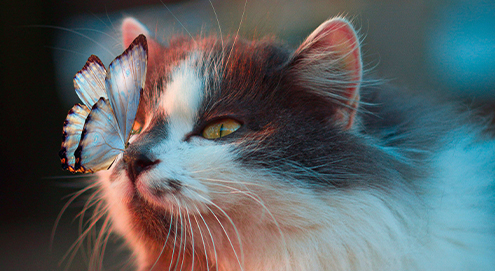A cat with hay fever, is that possible?
Written by Noa |
Just like humans, our cats can also suffer from hay fever and experience related symptoms. They react sensitively to pollen in their environment. These pollen are released once trees, plants, and grasses begin to bloom again — and that’s already well underway, as spring is approaching! But what exactly is hay fever? And what can you do to support your cat?

What is hay fever?
Hay fever causes an allergic reaction in the body when it comes into contact with the pollen of blooming grasses, plants, and trees. In other words: pollen. The immune system reacts overly sensitively to these pollen and starts producing substances to fight them. This leads to seasonal symptoms that are becoming increasingly common in cats as well.
What symptoms of hay fever can your cat show?
The symptoms of hay fever in cats largely resemble those we see in humans. These can vary from one cat to another, and their severity can differ as well. Your cat may even show multiple symptoms at the same time. You might notice your cat has sensitive or irritated eyes, bald patches in the coat, itching, brown discoloration of the fur due to excessive licking, or a runny nose.
Supporting your cat with hay fever
A pollen allergy can be very bothersome for your cat due to the discomfort it causes. They may feel unwell or even eat less. It’s important to always monitor this — your cat must keep eating at all times. Many symptoms we associate with hay fever may also result from a food or flea allergy. That’s why it’s important to first have medical causes ruled out by your vet. This will help determine whether a medical treatment is needed. In addition to a suitable treatment from your vet, there are several things you can do yourself to help relieve your cat’s discomfort.
Supplements to support your cat with hay fever
A strong immune system helps your cat reinforce the skin barrier from the inside out. Catoils is a concentrated, tasty fish oil with a high content of omega-3 fatty acids. These fatty acids are essential for cats because they cannot produce them on their own. Most cat foods contain a high level of omega-6. By adding Catoils, you achieve a better balance between omega-3 and omega-6 fatty acids, which supports your cat’s overall immunity.
For a direct soothing effect on the respiratory tract, you can use Groene Os Scutellaria Tincture, for example. Other products based on borage oil or evening primrose oil (both rich in fatty acids) may help to manage allergy symptoms.
Natural desensitisation for your cat
By gradually exposing the body to low doses of pollen, it learns not to react as strongly. This makes it less sensitive to pollen. Puur Pollen contains a dilution of all common grass and plant types. Giving your cat these drops over an extended period may reduce the severity of hay fever reactions.
In addition, the drops have a soothing effect on the respiratory tract.
Improve your cat’s skin barrier
By nourishing the skin with essential fatty acids and essential oils, your cat develops a stronger skin barrier. This can help reduce reactions to external allergens. With the simple application of Atop7 Spot-on, you support the skin’s natural recovery process and help bring it back into balance.



